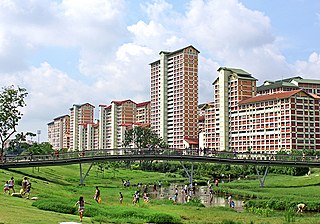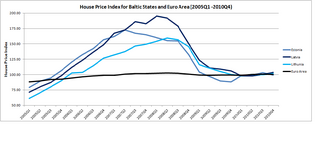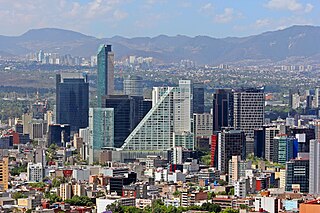
Public housing is a form of housing tenure in which the property is usually owned by a government authority, either central or local. Although the common goal of public housing is to provide affordable housing, the details, terminology, definitions of poverty, and other criteria for allocation vary within different contexts. Within the OECD, social housing represents an average of 7% of national housing stock (2020), ranging from ~34% in the Netherlands to less than 1% in Colombia.

A housing estate is a group of homes and other buildings built together as a single development. The exact form may vary from country to country.

Real estate economics is the application of economic techniques to real estate markets. It tries to describe, explain, and predict patterns of prices, supply, and demand. The closely related field of housing economics is narrower in scope, concentrating on residential real estate markets, while the research on real estate trends focuses on the business and structural changes affecting the industry. Both draw on partial equilibrium analysis, urban economics, spatial economics, basic and extensive research, surveys, and finance.

Canada Mortgage and Housing Corporation is Canada's federal crown corporation responsible for administering the National Housing Act, with the mandate to improve housing by living conditions in the country.

Suburbanization (AE), or suburbanisation (BE), is a population shift from historic core cities or rural areas into suburbs, resulting in the formation of (sub)urban sprawl. As a consequence of the movement of households and businesses away from city centers, low-density, peripheral urban areas grow.

Energy policy are the government's strategies and decisions regarding the production, distribution, and consumption of energy within a specific jurisdiction.The decisions regarding energy policy will affect how high the greenhouse gas emissions by that country are. Energy policy is closely related to climate change mitigation policies because the energy sector emits more greenhouse gas worldwide than any other sector. The attributes of energy policy include legislation, international treaties, guidelines for energy conservation, energy subsidies and other public policy techniques.

Affordable housing is housing which is deemed affordable to those with a household income at or below the median as rated by the national government or a local government by a recognized housing affordability index. Most of the literature on affordable housing refers to mortgages and a number of forms that exist along a continuum – from emergency homeless shelters, to transitional housing, to non-market rental, to formal and informal rental, indigenous housing, and ending with affordable home ownership.
The term "sustainable communities" has various definitions, but in essence refers to communities planned, built, or modified to promote sustainable living. Sustainable communities tend to focus on environmental and economic sustainability, urban infrastructure, social equity, and municipal government. The term is sometimes used synonymously with "green cities," "eco-communities," "livable cities" and "sustainable cities."

The energy policy of the European Union focuses on energy security, sustainability, and integrating the energy markets of member states. An increasingly important part of it is climate policy. A key energy policy adopted in 2009 is the 20/20/20 objectives, binding for all EU Member States. The target involved increasing the share of renewable energy in its final energy use to 20%, reduce greenhouse gases by 20% and increase energy efficiency by 20%. After this target was met, new targets for 2030 were set at a 55% reduction of greenhouse gas emissions by 2030 as part of the European Green Deal. After the Russian invasion of Ukraine, the EU's energy policy turned more towards energy security in their REPowerEU policy package, which boosts both renewable deployment and fossil fuel infrastructure for alternative suppliers.

Efficient energy use, or energy efficiency, is the process of reducing the amount of energy required to provide products and services. There are many technologies and methods available that are more energy efficient than conventional systems. For example, insulating a building allows it to use less heating and cooling energy while still maintaining a comfortable temperature. Another method is to remove energy subsidies that promote high energy consumption and inefficient energy use. Improved energy efficiency in buildings, industrial processes and transportation could reduce the world's energy needs in 2050 by one third.
On 26 November 2008, the European Commission proposed a European stimulus plan amounting to 200 billion euros to cope with the effects of the global financial crisis on the economies of the members countries. It aims at limiting the economic slowdown of the economies through national economic policies, with measures extended over a period of two years.
The Building and Construction Improvement Program(BACIP) is a program of the Aga Khan Planning and Building Service, Pakistan (AKPBS,P) that is engaged in developing and promoting solutions to housing and built environment-related issues of rural communities living in Gilgit-Baltistan and the province of Sindh.

The 2009 energy efficiency and renewable energy research investment was a part of the American Recovery and Reinvestment Act of 2009 and it increased federal funds in renewable energy. The package included $50 billion in spending and $20 billion in tax provisions. The research within the investment also increased; as a result $8.8 billion went into renewable energy research. The investment also included a boost for "green buildings". Federal buildings received $4.5 billion in renovations; public housing was also granted $4 billion in renovations. An additional $250 million was made out to energy-efficient affordable housing, in part by installing insulation. Environment America, an organization of state-based, environmental advocacy organizations, reviewed the final bill and stated there was $32.80 billion in funding for clean energy projects, $26.86 billion for energy efficiency initiatives and $18.95 billion for green transportation, totaling $78.61 billion just for "green" projects.
Green affordable housing is reasonably priced housing that incorporates sustainable features. The phenomenon has become increasingly common in all over the world as climate change and the cost of housing become alarming issues. For example, the United States adopted state and local policies that favor or require green building practices for publicly owned or funded buildings. Potential benefits of green affordable housing include lower energy cost burden and improved health. One challenge to green affordable housing is the tendency to prioritize short-term costs over long-term benefits, leading to higher upfront cost. The challenge for green housing advocates is to see to the life cycle cost of the building. Many affordable housing projects already find it a challenge to raise capital to finance basic affordable housing. This challenge is compounded by the phenomenon of urban greening and environmental gentrification, which can drive up housing prices and becomes a challenge for green affordable housing. Green affordable housing has taken form in traditionally wooden homes, green homes and most recently with 'upcycling' shipping containers.

Affordable housing in Canada is living spaces that are deemed financially accessible to those with a median household income in Canada. The property ladder continuum of affordable housing in Canada includes market, non-market, and government-subsidized housing.

The Baltic states' housing bubble was an economic bubble involving major cities in Estonia, Latvia and Lithuania. The three Baltic countries had enjoyed a relatively strong economic growth between 2000 and 2006, and the real estate sectors had performed well since 2000. In fact, in between 2005Q1 and 2007Q1, the official house price index for Estonia, Latvia and Lithuania recorded a sharp jump of 104.6%, 134.3% and 106.7%. By comparison, the official house price index for Euro Area increased by 11.8% for a similar time period.
Public plans for energy efficient refurbishment are put in place by states to encourage building owners to renovate their properties in a way that increases their energy performance. As financing represents the most important obstacle to this type of renovation, the plans favour financial incentives in the form of loans or grants. Various institutions can be involved in the process, such as ministries, banks, firms, or energy services companies (ESCOs).

Housing in the United Kingdom represents the largest non-financial asset class in the UK; its overall net value passed the £5 trillion mark in 2014. Housing includes modern and traditional styles. About 30% of homes are owned outright by their occupants, and a further 40% are owner-occupied on a mortgage. About 18% are social housing of some kind, and the remaining 12% are privately rented.

Affordable housing is housing that is deemed affordable to those with a median household income as rated by the national government or a local government by a recognized housing affordability index. A general rule is no more than 30% of gross monthly income should be spent on housing, to be considered affordable as the challenges of promoting affordable housing varies by location.

Mexico City has massively been expanding its urban fabric and population density, becoming the fifth largest city in the world. A combination of neoliberal policies, complex geographic location, socio-economic disparities and inefficient strategies have influenced the process of gentrification en la city. The combination of numerous megaprojects and inefficient city-planning strategies have led to dysfunctions in circulation, community allocation and equal access to resources. In consequence, middle and low-income communities have been directly or indirectly alienated and challenged to adapt to a complex and evolving urban environment.





















